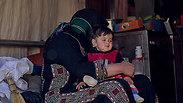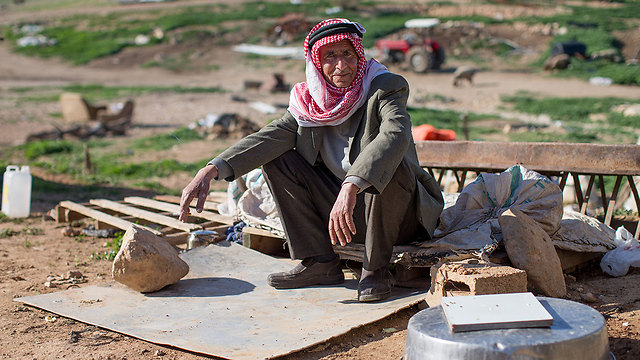
B’Tselem: 2016 a record year in Israeli demolitions of Palestinian homes
A new report reveals that Israel destroyed 274 structures in the West Bank last year, leaving 1,134 people homeless. ‘This reflects Israel’s increased efforts to reduce the Palestinian presence in the areas it is attempting to take over through planning and administrative measures,’ the NGO says.
The area accommodates three Palestinian families from the Bany Maniya clan. Seventeen people live there in the most basic conditions imaginable: A few tents, a sheep pen, a tiny beehive and water that comes from a nearby natural spring. There is no electricity.
The force arrived to demolish a few tin shacks and confiscate two or three tents in which the families live. There were no Israeli, Palestinian or international media crews waiting there. Zuhir Bany Maniya, the head of the families, was forced to cope with the situation on his own. The mission was completed within short order and the forces left the area.
“They arrived in the morning hours and told me that this is an IDF training area and that we can’t live here, but we have been here for 35 years now. We are simple shepherds. There are no settlers here, there are no agricultural crops here, there is nothing here,” Bany Maniya says, pointing to the rocky ground and the bald hills. “I don’t understand what they want from us and who is it that we are disturbing.”
Until 2012, there were six families living in the area. Today, only three are left.
The Bany Maniya story, it turns out, is one of many. A new report released by the B’Tselem organization shows that 2016 was a record year in terms of building demolitions in the West Bank since the organization began documenting these activities in 2004.
B’Tselem members believe this is no coincidence. “These demolition activities reflect Israel’s increased efforts to reduce the Palestinian presence in the areas it is attempting to take over through planning and administrative measures,” an organization official says.
‘I have no documents’
Area C in the West Bank is under full Israeli civil and military control. For the 200,000-300,000 Palestinians living there this means that every part of their lives depends on the Israeli authorities.
According to the B’Tselem report, throughout 2016 Israel demolished 274 homes in the West Bank (excluding east Jerusalem), leaving 1,134 people—including 591 minors—homeless. The extent of demolitions in 2016 exceeded the extent of demolitions in the two preceding years together, and a review of the demolition map reveals that the Israeli government focuses its efforts primarily in three areas: South Mount Hebron, the Ma’ale Adumim area and the Jordan Valley.
The policy is very similar in east Jerusalem too. Over the past year, Israeli authorities have demolished 73 homes and 48 other structures, leaving 295 people—160 of them minors—without a roof over their heads.
The tin huts, tents and structures being destroyed by Israel were built without a permit, but the Palestinian residents and human rights organization claim there are two sides to the story. The number of zoning plans for Palestinian villages that are in the process of obtaining approval from the Civil Administration is minimal compared to the size of the population there. Every year, hundreds of plans are submitted for approval, and only few are approved.
An exception took place in 2016 as well. According to figures provided by the Civil Administration recently to the non-profit organization Bimkom, the Administration issued 37 building permits for Palestinians in Area C. This is an unprecedented high number, but a Bimkom examination revealed that 35 of these permits were issued at the request of the Administration itself, which plans to forcibly move Bedouin communities living east of Ma’ale Adumim to advance a controversial building plan that was frozen in the past following international pressure.
The lands the communities sit on are being declared as fire practice areas, and the fact the clans have been there for many years doesn't help them pass the legal property test. “In the past, there were no lands belonging to private people but to clans, and each clan had its own area which was recognized and accepted by everyone,” Bany Maniya says. “Today I have no document proving that this land belongs to me, so I cannot go to court either.”
‘I will never move away from here’
From 'Ein al-Karzaliyah we continued northward on Route 90. We met Mahmoud Awad Ayoub, who lives with his family in a wadi surrounded by two hills that are turning green, about 4 kilometers south of the Mehola Junction.
Ayoub welcomes us with traditional coffee near his tent, opposite the ruins of what used to be his sheep pen. “I have lived here almost my entire life,” he says. “Everything I know is from this mountain to the next mountain,” he points to the two hills. “Since Israel came, they keep telling me that this land is only for agriculture and not for living, and that therefore we cannot stay here.”

But although Ayoub and his family are required to evacuate the land, which the authorities say can only be used for agriculture, an outpost named Givat Salit has been established just 200 meters away.
“Why can they stay here? Why isn’t anyone destroying what they built?” he asks, frustrated. “They want me to emigrate from here, but I will never move away from this land. I have no relations with the settlers here, neither good nor bad. All I want is to work and live in peace with the world.”
Between our visit to the Jordan Valley and the release of this report, the Civil Administration has demolished eight buildings in Khirbet Ras al-Ahmar in the northern Jordan Valley.
The Coordinator of Government Activities in the Territories unit offered the following response: “The Civil Administration conducts enforcement operations against illegal construction in Judea and Samaria in accordance with the political echelon’s instructions.
“In the past year, the Civil Administration approved zoning plans for the villages of Taanakh and Izbeit at-Tabib, and these days it is advancing the zoning plans of the city of Qalqilya, Nabi Ilyas, Hableh and Dahar al-Malakh. In addition, the Civil Administration is looking into and advancing several plans to legalize infrastructure and housing for the Bedouin population in Judea and Samaria, in the Ma’ale Adumim area and the Jordan Valley, as part of which the families will be allotted plots of land including proper housing infrastructures such as water, electricity and sewage, while maintaining the population's lifestyle.
“About two years ago, the Civil Administration approved such a plan near Abu Dis, which is ready to take in the families, but unfortunately they are refusing to move to this place and legalize their planning status.
“Such a plan was implemented several years ago in the old neighborhood of Jahalin in Abu Dis. It included the construction of some 200 legal structures in which families live today.”











